Shindo Laboratory Aurièges
Original Two-Chassis, Full-Function Preamplifier
Review Number 1 in the C/H/E* Files.
By Steve Graham
*Classic/Heritage/Exotic
This is the first instalment of what, hopefully, will be many evaluations of what I call the Classic/Heritage/Exotic equipment category. I think the original, two-chassis Shindo Aurièges pictured above could fit in all three.
The esteemed Art Dudley of Stereophile usually bangs on about his Shindo gear nearly every other month in his column. I’m being a bit snarky with Mr. Dudley, but he is doing his reviewer’s job, using what for him is his reference as a guide to new equipment sent to him for review. I’ve always enjoyed Art’s style of using clear, unfanciful language to communicate his impressions. It’s a shame Art cut back on his political commentary a few years ago. I enjoyed it almost as much as his equipment musings.
But back to “my” Shindo. This is a kind loaner from the personal system of Peter Wolter, proprietor of Being There Audio in Orangeville, Ontario. Thanks Peter, you are very kind to loan this gear. I’d be more hesitant than you if it was mine to lend, to the likes of me. Peter is of the opinion that Shindos of a vintage similar to his have better looking paintwork and front panels than those more recently built. One item of Shindo lore is the metallic green paint, chosen by the late Ken Shindo to grace his products. Supposedly he was inspired by the colour Altec painted their speaker baskets in the 1950’s and 60’s. The speaker baskets on the woofers in my Altec Flamencos are painted a lighter shade of hammertone green. The metallic green on the Aurièges is darker and much richer looking.
Peter’s Shindo Auriegés is an earlier vintage. I say vintage a bit tongue-in-cheek, as most Shindo products are named after French wines or wine-growing regions. The current Aurièges preamps (there are line-only and line+phono versions) are single-chassis components, whereas Peter’s is the original two-chassis version, line and phono stage in one, power supply in the other. I’m not exactly sure of the vintage of this one, but I believe it was built around 2006/2007. For a more detailed description of the two-chassis Aurièges, see Mr. Dudley’s 2007 article in Stereophile. . The classic, two-chassis Aurièges line stage+ phono, sold for US $3,895 back in 2007.
Let’s set out some terms of reference:
If a collector’s item, is all you want, you can stop reading here and fire up your favourite search engine. If you want to know how this C/H/E component will fare for music listening, read on.
I’m not saying collecting is bad, it’s often just a waste. Why have something just to look at or stash away as an investment hoping it will appreciate in value. Sure, a Dino 246 from the late 1960’s through to the mid 1970’s is a beautiful object – but it was, and still is, meant to be driven. For a while, all non twelve-cylinder Ferraris were called Dinos in honour of Mr. Ferrari’s late son Alfredo (Dino).
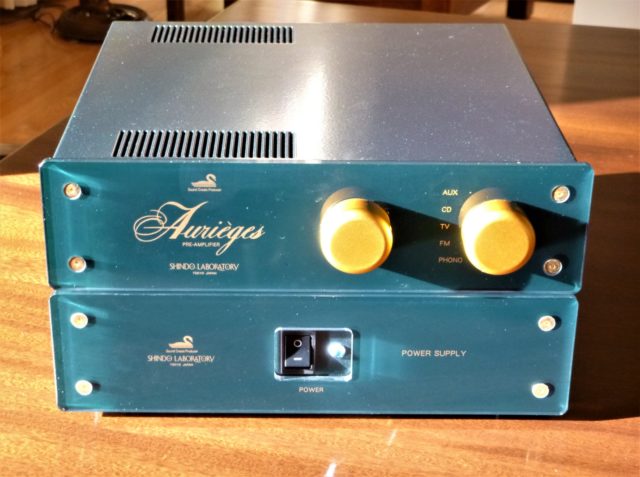 Same with the iconic Ducati 916. Yes, it’s beautiful, but leaning it into a corner with that V-twin bellowing away is what it was meant for. I haven’t driven a Ferrari, but I’ve ridden a 916. My youngest brother (see https://www.thebluegroove.com) has a first-year 916, that I was able to ride once. I had done some work on it so it only seemed fair. When I got on his 916 and accelerated away, it felt like a refined version of my old 900SS (formerly my brother’s old 900SS). I ran it up through the first three gears, not real hard but reasonably sporting, and at first I thought it didn’t have much giddy-up. I looked at the speedo and it said 70. Then I realized it was MPH, not KPH. That’s over 110 KPH, to those of you who are imperially challenged. Brother’s bike had been imported from the US, and as such the speedo reads in MPH. Sure, the 916 makes less than half the horsepower of the current top-of-the-line Ducati sport bike. To a chicken-rider like me it’s still a lot of fun. Even at about 90 horsepower, my brother likes to power slide it around paved corners, dirt-track style. He races in dirt track occasionally and road-races a Ducati 851 in a vintage series, the consequences of which you’ll see if you visit his site.
Same with the iconic Ducati 916. Yes, it’s beautiful, but leaning it into a corner with that V-twin bellowing away is what it was meant for. I haven’t driven a Ferrari, but I’ve ridden a 916. My youngest brother (see https://www.thebluegroove.com) has a first-year 916, that I was able to ride once. I had done some work on it so it only seemed fair. When I got on his 916 and accelerated away, it felt like a refined version of my old 900SS (formerly my brother’s old 900SS). I ran it up through the first three gears, not real hard but reasonably sporting, and at first I thought it didn’t have much giddy-up. I looked at the speedo and it said 70. Then I realized it was MPH, not KPH. That’s over 110 KPH, to those of you who are imperially challenged. Brother’s bike had been imported from the US, and as such the speedo reads in MPH. Sure, the 916 makes less than half the horsepower of the current top-of-the-line Ducati sport bike. To a chicken-rider like me it’s still a lot of fun. Even at about 90 horsepower, my brother likes to power slide it around paved corners, dirt-track style. He races in dirt track occasionally and road-races a Ducati 851 in a vintage series, the consequences of which you’ll see if you visit his site.
Sorry, I’m back from one of my tangential diversions. The Shindo Aurièges. With HiFi gear we can potentially have our cake and eat it too. You may look at your beautiful Shindo, it will likely appreciate in value and you can enjoy its reproduction of music. The only downside is you’ll need fresh tubes every once in a while. That’s a lot less expensive and far less humbling than throwing an iconic motorcycle down the road.
This “classic” Aurièges features three pairs of line input jacks, though there are four line input positions on the selector switch, plus a moving-magnet phono input. Moving magnet is the only phono input a preamp should have in my opinion. Personally, I see little sense in manufacturers including moving coil step-up transformers (SUTs) in their preamps. Selection of a MC transformer is such a personal decision for an analogphile. To have the preamp manufacturer pick one and build it in seems too arbitrary considering it could be sub-optimal. SUT selection can be very dependent on the cartridge it will be paired with. (Editor’s Note: most built-in “MC stages” aren’t even SUT-based, A shame too.)
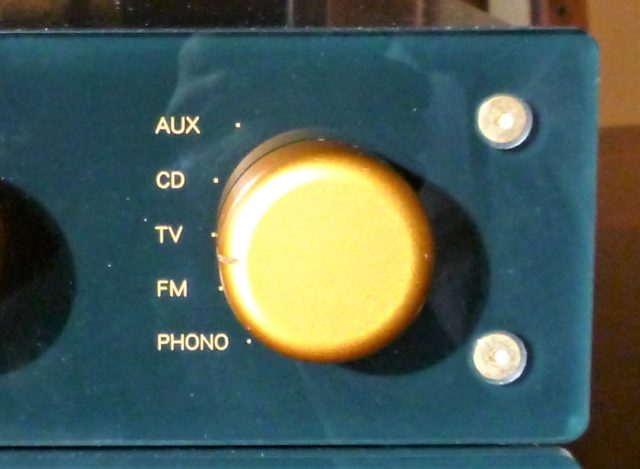
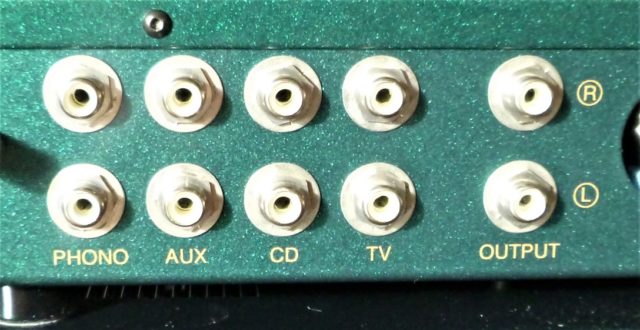
To call Shindo Laboratory a builder or a manufacturer is, from what I’ve read, to do them a disservice. Shindo is more of a master vintner. The late Ken Shindo amassed large quantities of what were then, and to some degree now, parts deemed not worthy by many of audiophile consideration. But Shindo go their own way. The classic Switchcraft RCA jacks, that probably sold for 25 cents each, back in the day, were and are deemed by Shindo to be the one most suitable for their amplifiers. This is but one example of many instances of classic NOS parts used in Shindo products.
Listening to the Aurièges:
I’m unsure if Peter’s Aurièges is up to factory specs. Had I just purchased it, with the number of hours on the installed tube set not known, replacing the tubes would likely be a priority. Even with those unknowns, I gave it a go in my reference system to hear what shakes out.
Now I don’t claim to be a golden-eared audiophile, to separate the various shades of gold is something I’m loath to attempt. I might not be able to grade a component to a single digit percentage point, but I can tell when something is not quite as it should be, as it was when I was listening to a pair of speakers recently. Their bass was a bit over-damped and the highs slightly over-bright. But there was something else missing which resulted in my inability to engage with any music played on them. Part of the midrange just seemed, well, wrong. The builder retrieved them and later reported back that the HF drivers, crossed over at 1,500 Hz, were defective.
Line Stage:
I departed from my usual all-balanced system to put the Aurièges on a more level playing field. My Audio Research Reference 3 line stage was benched in favour of an Aikido Max. I call it Max because it is in essence, if not exactly, a maxed-out version the Aikido line stage built in our DIY series from a couple of years ago. The Max, a two-chassis concoction, has separate regulated power supplies for filaments and H.T., an Alps Black Beauty stepped attenuator, some upscale output caps, and is wired on turret boards. The high-level source was my NAD 50.2 digital music player, feeding a Cambridge 840C, CD player/DAC. On the output side of the line stage, my usual ARC Ref 110 and PSB T8’s handled power amplification and loudspeaking duties.
The Aikido Max was the best line stage I’ve heard in my system short of the ARC Ref 3. Now it has moved down a notch. The Aurièges has bettered it noticeably. In the highs it’s more detailed, but also smoother sounding than the Aikido. From Miles Davis on 24/192 download, to Bob Marley on 24/96 equivalent streamed MQA, the Aurièges just breathes easier in the upper octaves. Not by a lot, but noticeably. Now this wasn’t full MQA decode, just the first unfold performed by the NAD 50.2. A new, fully MQA-capable DAC is in my budget for late this year or early next.
The extra detail was a mixed blessing with CD resolution material. Loreena McKennitt’s latest album Lost Souls, revealed the glassy nature characteristic of the worst of 16/44. But glassy or not, if you can listen to Breaking Of The Sword without getting a lump in your throat you’re a harder bastard than I.
Through the midrange, the Aurièges was more expressive than the Aikido. The saxes, Bill Evans’ piano and Miles Davis’ trumpet on the 24/192 Kind Of Blue were just that bit more relaxed, airy and engaging. The Aurièges didn’t lack for pace and rhythm, but the Aikido was slightly more forceful in the low bass region around 50Hz.
I don’t put a great deal of value on imaging or soundstaging, or perhaps it would be more accurate to say I don’t listen specifically for it, but the Aurièges was definitely more spacious and airier than the Aikido.
Given the choice, financial considerations aside, I’d go for the Aurièges for listening to high level sources.
Line plus Phono:
For an analogue source, I used my usual Pro-Ject “The Classic” SB Super Pack with Ortofon Quintet Bronze LOMC cartridge, into a K&K Premium MC SUT. When not using the phono stage built into the Aurièges, the prototype Tubecad Tetra phono stage from the WoS DIY series was hitched up to one of the line inputs.
You might suggest that another set of interconnects, when connecting the Tetra to the Shindo’s line inputs, might have made some difference, and I wouldn’t argue. Component interactions could be playing a part as well. At this level of performance everything matters, exactly how much is hard to say.
That being said, the Shindo through its phono inputs was very pleasant. It didn’t beat the Tetra hands down, but overall it was superior. Everything was more spacious and detailed through the Shindo, not by a huge margin, but noticeably. Voices, both male and female, were just that bit clearer, which made them sound more human. Percussion was more detailed, but not hyped up or too bright. With well-recorded acoustic stringed instruments, their wood bodies seemed more alive and present. The bass through the Shindo was more muscular, but not as well controlled as the Tetra. Electric bass seemed a bit too plummy and loose a la Shindo.
The reason for the Shindo’s bass looseness is that it might not be loading the K&K SUT optimally. There are 100K ohm resistors across the jacks of the phono inputs. The K&K is expecting to “see” about half this, the standard 47K ohms. The Tetra has 47K ohm resistors on its input. See my K&K SUT review for a more detailed discussion on loading.
I don’t want to throw shade, as is said in contemporary parlance, on the Tetra. It is a good value phono pre that can be had for about $500 US, plus a bit of sweat equity (link). Music just seemed to live and breathe more easily and fully through the Shindo.
Summary:
The question I like to ask myself is, would I plunk down my own money on a particular piece of stereo gear? When you look inside the Shindo (sorry Peter, I had to take a peek), it’s hard to justify the price on parts quantity and quality. People make a big deal out of the selected NOS components but some of them look very prosaic indeed.
I wouldn’t say the industrial design was all that special either. Some have spoken about how the chassis fits together nicely, but an Elekit fits together well too. Maybe it’s a Japanese thing. As far as the paint-work on the chassis goes, it’s nice, but a new Honda Civic has a smoother, more even paint job.
Had I not gone down a completely different path with my equally exotic, but completely different, fully balanced ARC gear, and I could set my time machine back about ten years, I would have ponied up the dough for the Shindo Aurièges, based on the quality of music reproduction offered. There, Maple Grove, Minnesota, I’ll bet that’s the first time you’ve been called exotic.
As much as it’s fun to be a contrarian, I have to agree with Mr. Dudley. In my limited experience with Shindos, they do reproduce music in a lovely and engaging way.
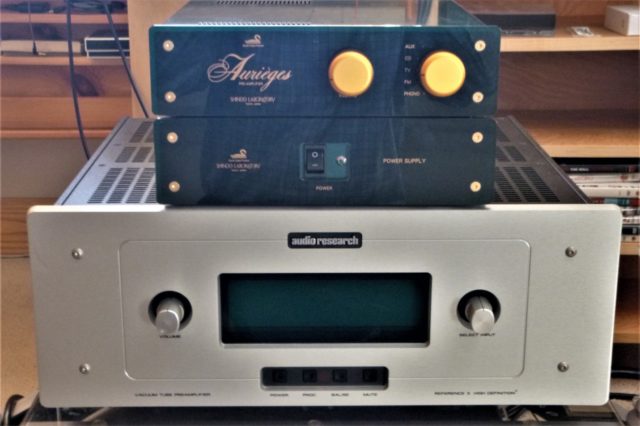
_____________________________________________
Editor’s Comment: Dear Steve, if you have to throw a bike down the road, please make sure it’s a Norton, not a Ducati.

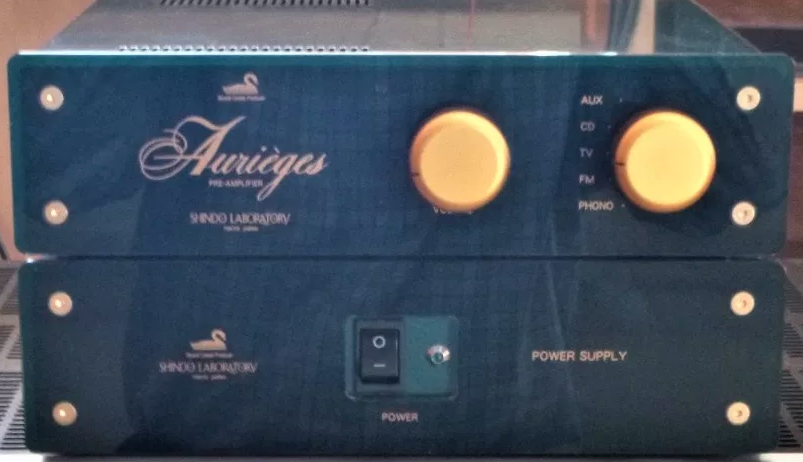

Great observations Steve,
I might add that using a matching amp
(as Art does) might also give insight
Into how these products sound.
(I have Fi/Garber amp and pre)
Happy Listening
Mike
I am enjoying a new Aurieges with a second hand (about 6 years old) Shindo Montille amp. I have never been so entralled with the music – this combo is feeding my musical soul like never before. No doubt there is more “better” to be had; more this, better that, deeper, wider, higher, tighter, more resolved, and on and on. But I am weary of the constant search and instead learning how to settle in and just enjoy. The Shindos are the first amplification components in my experience to support this refreshing and freeing state of audiophile mind.
Low powered tube amplification, high sensitivity speakers – there’s a certain magic…
The green paint is horrible .Pride of ownership is close to nil! This is an overpriced cheapo!Snake oil ?
@RDSolheim. Then don’t buy one! Besides pride is a major deadly sin.
With my fabulous collection of class A tube amps From Nagra and Audio Power Labs I see no reason to ever have this Shindo crap in any of my Houses, Would not even use them in any of my 14 garages !